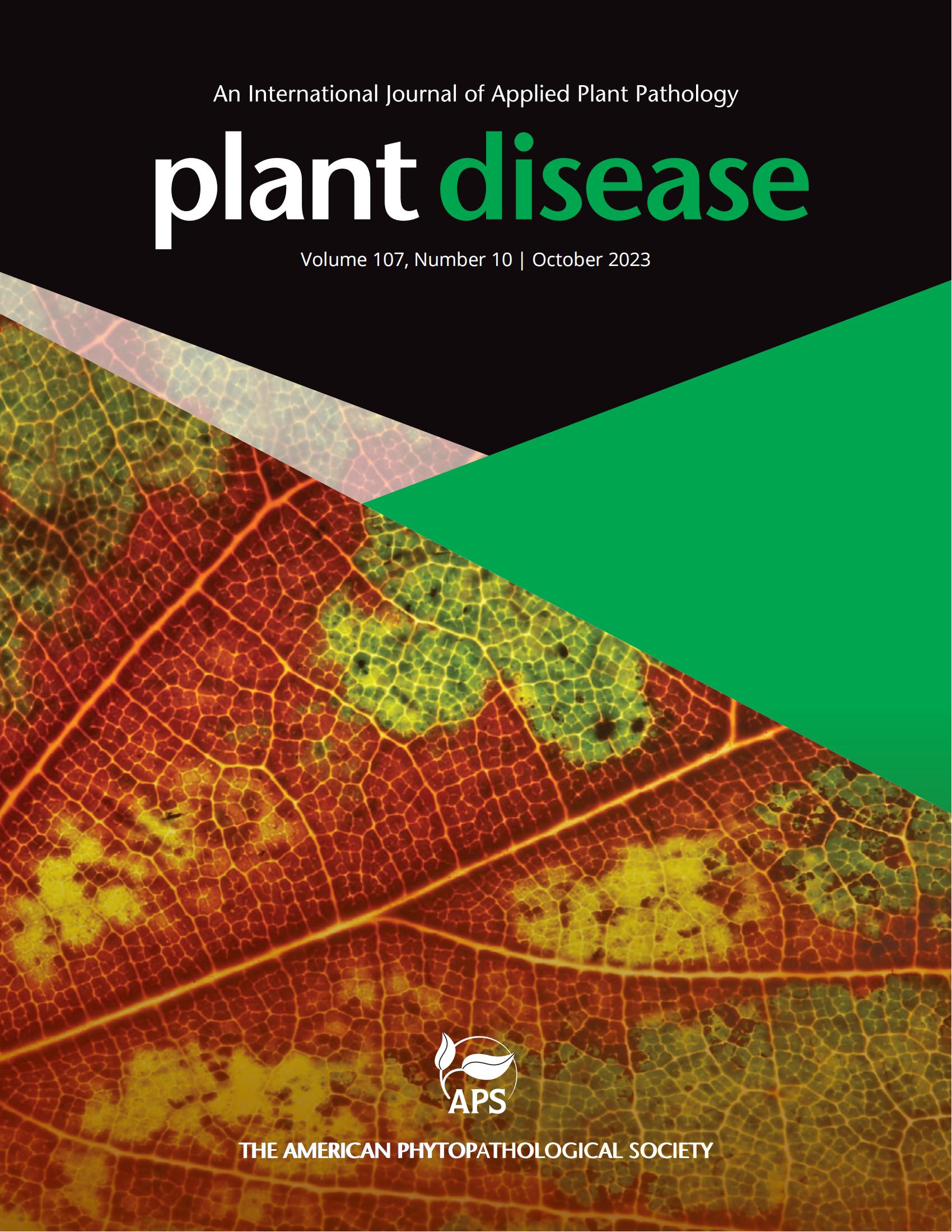中国由柠檬酸炭疽菌引起的石斛叶炭疽病首次报道。
摘要
石斛(Dendrobium nobile)是兰科的一种珍稀兰花,是一种具有抗肿瘤、抗衰老、降血糖等多种生物活性的传统中草药(Fan et al. 2023)。2025年2月,在浙江中医药大学药用植物园内(30.08°N, 119.88°E)观察到叶炭疽病的症状。疫区面积约25平方米,发病率约为55%。这种疾病的症状开始于叶子边缘,那里首先出现了淡黄色的斑点。随着病变的扩大,它们变成不规则的棕色或黑色斑块。受感染的叶子边缘干涸,形成大面积的坏死区域,有深棕色斑点,最终导致落叶。6个有症状的叶片样品(5×5 mm)用75%乙醇表面消毒30 s,然后用2.5% NaClO表面消毒1分钟。风干后,将组织置于马铃薯葡萄糖琼脂(PDA)培养基上,28℃孵育5天。采用菌丝尖端分离法分离得到两株真菌DNLP07和DNLP08。PDA上菌落表面呈白色棉状,背面为白色,黄褐色变色,两侧可见同心圆环。分生孢子为单细胞、分离,圆柱形至椭圆形,直径21.6 ~ 31.1 × 9.5 ~ 14.9 μm(平均25.9 × 11.7 μm;n = 50)。这些形态特征与炭素trichum citricola一致(Fu et al. 2019)。扩增了6个基因区域:内转录间隔物(ITS)、肌动蛋白(ACT)、钙调蛋白(CAL)、几丁质合成酶(CHS)、甘油醛-3-磷酸脱氢酶(GAPDH)和β -微管蛋白2 (TUB2)。引物分别为ITS1/ITS4、ACT-512F/ACT-783R、CL1C/CL2C、ch - 79f / ch - 345r、GDF/GDR和T1/Bt2b (Weir et al. 2012)。结果序列提交给GenBank,登录号如下:ITS: PV271806, PV271807;Act: pv287640, pv287641;Cal: pv287638, pv287639;Chs: pv287642, pv287643;Gapdh: pv287644, pv287645;Tub2: pv287646, pv287647。BLASTn分析显示,分离物DNLP08与citricola型菌株CBS 134228序列同源性为99% ~ 100%,包括ITS (KC293576;468/468 bp), ACT (KC293616;268/270 bp), CAL (KC293696;424/425 bp), CHS (KC293792;278/278 bp), GAPDH (KC293736;239/239 bp)和TUB2 (KC293656;487/488的英国石油公司)。利用MEGA 11的串联序列数据构建最大似然系统发育树,结果表明两个分离株均与citricola聚类。为证实其致病性,将分离的DNLP08分生孢子悬浮液(1×106孢子/mL)喷洒在3株健康的野牡丹上。另外三株植物用无菌蒸馏水处理作为对照。所有植株保持在28°C, 85%相对湿度和12小时的光周期。12天后,接种植株出现与田间观察相同的症状,而对照植株仍无症状。该病原菌成功地从有症状的叶片中分离出来,并根据六个基因的形态特征和序列数据进行了鉴定,满足了Koch的假设。对照植物中未分离出病原菌。本研究首次报道了在中国引起野田鼠叶炭疽病的柠檬酸枝孢杆菌。准确的病原鉴定是今后有效预防和控制该病的重要基础。Dendrobium nobile, a rare orchid in Orchidaceae, is a traditional Chinese medicinal herb known for its diverse biological activities, including anti-tumor, anti-aging, and hypoglycemic effects (Fan et al. 2023). In February 2025, symptoms of leaf anthracnose were observed on D. nobile plants growing in the medicinal plant plantation of Zhejiang Chinese Medical University (30.08°N, 119.88°E), China. The affected area covered approximately 25 m2, with a disease incidence of around 55%. The disease symptoms began at the leaf edges, where light yellow spots first appeared. As the lesions expanded, they turned into irregular brown or black patches. The edges of the infected leaves dried out, forming a large necrotic area with dark brown spots, ultimately leading to defoliation. Six symptomatic leaf samples (5×5 mm) were surface sterilized with 75% ethanol for 30 s, followed by 2.5% NaClO for 1 minute. Afterair-drying, the tissues were placed on potato dextrose agar (PDA) medium and incubated at 28°C for five days. Two fungal isolates, DNLP07 and DNLP08, were obtained using the hyphal-tip isolation method. On PDA, the colonies appeared white and cottony on the surface, with a white reverse side, yellow-brown discoloration, and concentric rings visible on both sides. The conidia were single-celled, aseptate, cylindrical to oval, measuring 21.6-31.1 × 9.5-14.9 μm (average 25.9 × 11.7 μm; n=50). These morphological characteristics were consistent with those of Colletotrichum citricola (Fu et al. 2019). Six gene regions were amplified: internal transcribed spacer (ITS), actin (ACT), calmodulin (CAL), chitin synthase (CHS), glyceraldehyde-3-phosphate dehydrogenase (GAPDH), and beta-tubulin 2 (TUB2). The following primer sets were used: ITS1/ITS4, ACT-512F/ACT-783R, CL1C/CL2C, CHS-79F/CHS-345R, GDF/GDR, and T1/Bt2b, respectively (Weir et al. 2012). The resulting sequences were submitted to GenBank with the following accession numbers: ITS: PV271806, PV271807; ACT: PV287640, PV287641; CAL: PV287638, PV287639; CHS: PV287642, PV287643; GAPDH: PV287644, PV287645; TUB2: PV287646, PV287647. BLASTn analysis showed that the isolate DNLP08 shared 99% to 100% sequence identity with the C. citricola type strain CBS 134228, including: ITS (KC293576; 468/468 bp), ACT (KC293616; 268/270 bp), CAL (KC293696; 424/425 bp), CHS (KC293792; 278/278 bp), GAPDH (KC293736; 239/239 bp), and TUB2 (KC293656; 487/488 bp). A maximum likelihood phylogenetic tree was constructed using the concatenated sequence dataset in MEGA 11, which showed that both isolates clustered with C. citricola. To confirm pathogenicity, a conidial suspension of isolate DNLP08 (1×106 spores/mL) was sprayed onto three healthy D. nobile plants. Three additional plants were treated with sterile distilled water as controls. All plants were maintained at 28°C with 85% relative humidity and a 12-hour photoperiod. After 12 days, the inoculated plants developed symptoms identical to those observed in the field, while the control plants remained asymptomatic. The pathogen was successfully re-isolated from symptomatic leaves and identified based on morphological features and sequence data from the six genes, fulfilling Koch's postulates. No pathogens were isolated from the control plants. This study first reports C. citricola causing leaf anthracnose on D. nobile in China. Accurate pathogen identification lays a crucial foundation for future effective prevention and control of the disease.

 求助内容:
求助内容: 应助结果提醒方式:
应助结果提醒方式:


